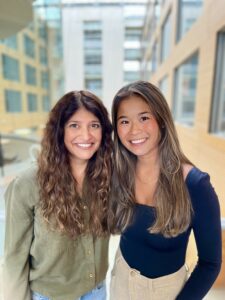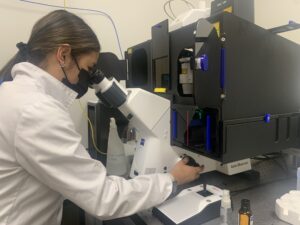Angie Peng is a second-year UBC School of Biomedical Engineering student who is working with Dr. Shernaz Bamji as part of the SBME Synergy Undergraduate Summer Research Program. We caught up with Angie to learn more about her experience in the program.
Why did you apply to the Synergy program?
 As a second-year undergraduate student, it can be quite challenging to gain hands-on research experience and this program solved that problem by directly connecting lower-year undergraduate students with unique research opportunities at UBC. Getting to work on a defined research project with a faculty member was an incredible prospect.
As a second-year undergraduate student, it can be quite challenging to gain hands-on research experience and this program solved that problem by directly connecting lower-year undergraduate students with unique research opportunities at UBC. Getting to work on a defined research project with a faculty member was an incredible prospect.
In addition, the program also offered professional development resources ranging from research skill workshops and career development seminars to online resources, which was especially appealing to me to help grow my career profile. The collaboration and interdisciplinary nature of the program across the Djavad Mowafaghian Centre for Brain Health, Centre for Blood Research, International Collaboration on Repair Discoveries (ICORD) and Genome Science and Technology Graduate Program (GSAT) also gave me the opportunity to expand my peer network outside of the School of Biomedical Engineering.
What is the research project that you are working on this summer?
My research project looks at factors that impact myelination rates, with future applications in regenerative medicines for patients with various neurological disorders. Myelination in the central nervous system is the process by which neuronal axons are ensheathed by a lipid dense wrapping that is produced by oligodendrocyte cells. Damage or loss of myelin can result in a variety of diseases or impairments, including multiple sclerosis and intellectual disabilities.
Working alongside PhD student Rocio Hollman, I studied the role of the palmitoylating enzyme ZDHHC9 in oligodendrocyte development and function in the corpus callosum of the brain. By analyzing electron micrograph images from wildtype and ZDHHC9 knock-out (KO) mice, we observed a significant reduction in the number of myelinated axons in the KO mice. Using Fluorescence In Situ Hybridization (FISH), we found that the decreased number of myelinated axons may be due to a disruption in the maturation of oligodendrocytes. Overall, this research provides new perspectives on the role of ZDHHC9 in oligodendrocyte development and shows evidence that palmitoylation contributes to the development and function of oligodendrocytes.
What are some of the skills, tasks and activities that you are learning and taking part in while in the lab?
 I have learned an immense amount of skills in the time I have spent in Dr. Bamji’s lab. As a 2020 high school COVID graduate, I never had any hands-on lab experience outside of my high school chemistry class. My first year of university was entirely online, and I had only taken a few in-person laboratory courses in my second year.
I have learned an immense amount of skills in the time I have spent in Dr. Bamji’s lab. As a 2020 high school COVID graduate, I never had any hands-on lab experience outside of my high school chemistry class. My first year of university was entirely online, and I had only taken a few in-person laboratory courses in my second year.
By working in the Bamji lab, I have practiced and begun to perfect basic techniques and skills ranging from pipetting, creating solutions and autoclaving. I have also learned how to handle mice properly, and how to perform euthanasia, brain sectioning using a cryostat, shadowed brain perfusions and dissections.
Rocio and I also generated a new protocol of extracting the myelin from a whole brain, and used this to perform further protein and genetic analyses. In addition, I also got the opportunity to perform full immunohistochemistry staining experiments and was introduced to the use of ultra-centrifuges and electron microscopes.
Along with experience in the lab, I have also developed career skills, such as communication, organization and time management, while gaining insights into professional workplace behaviour and interactions.
Outside of the laboratory, the Bamji lab is a tight-knit group. In the few months I have been a part of the lab, I have participated in various social events including movie nights, homemade pizza evenings and Vancouver Whitecaps soccer games. The Bamji lab has not only given me a wide variety of laboratory skills and research opportunities but also provided me with my own little lab family!
What are your future career goals?
To be honest, my future career goals have fluctuated quite a bit since joining the Bamji lab. For the majority of my life, I had wanted to go to medical school after completing my undergraduate degree. A large motivation for this was the passing of my grandmother at a young age and also the onset of my own personal illness. However, the time spent in the lab has begun to shift my passion toward a career in research and academia.
How has this experience changed your outlook on science or research?
My time spent in the Bamji lab has truly been incredible, and I have discovered the adrenaline rush and excitement which comes with research. Partaking in groundbreaking research is an incredible sensation, with feelings of utmost fulfillment and contribution.
I was unaware of how large the scientific and research community really was until this experience. It is unbelievable how much groundbreaking research occurs at UBC on a daily basis. Through the Synergy program, I have learned that research acts as the fundamental base for tackling nearly all scientific and medical mysteries. It is fascinating to know that cures and treatments for so many different types of diseases can be found within the setting where I worked. Overall, this experience has expanded my understanding of science and research, and the important role they play in humanity’s future.


